 |
||
|
||
| ||
The world is restless. Storms, bustles, battles... The History repeated the same sharp and irretrievable act with 3dfx Interactive, as it once committed with huge Byzantine and Roman Empires, leaving a former king of 3D-graphics empire in the gaming field alone with earlier launched products and without perspectives of support and many technological facilities. The XX century has taken away not only this company who conquered hearts of thousands users and left in the memory the nostalgia on the first game CDs with a writing "3Dfx"... It also turned another page of the chronicle of the computer industry; ahead, unclear image of the NVIDIA NV20 could be seen on the horizon, the ATI RADEON2 flies as an easy cloud. Now is coming a sunrise of new products, new technologies, but still unreleased 3dfx products are causing anxiety. But now let's come down to the see whether the NVIDIA GeForce2 GTS releasing now are so weak. But no, for the vast majority games this chipset (and the boards based on it) is more then enough. Moreover, the most popular GPU - NVIDIA GeForce2 MX, offering much less potential, still leaves its users satisfied. We have already considered many video cards on this GPU. Today we are examining one more product on the GeForce2 GTS. The product is rather beneficial, since the Gigabyte GA-GF2000 is the cheapest video card on the best chipset of 2000. Gigabyte company needs no introduction; it's the oldest manufacturer of the basic components for the system block. Its products are well known not only for their reliability and high quality, but also for some peculiar features. Now comes the Gigabyte GA-GF2000 video card itself. BoardThe card has the AGP 2x/4x interface, 32 MBytes DDR SGRAM located in 8 chips on the both sides of the PCB. 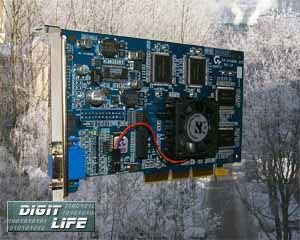 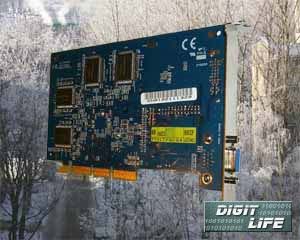 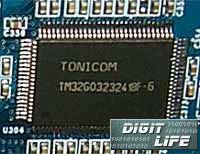 The memory chips are produced by CTS COMPUTER TECHNOLOGY SYSTEM (Tonicom) and intended for 166 (333) MHz. Interestingly that it's the first case when little-known manufacturers provide video cards of such level with memory chips. Besides, many got used to the fact that the GeForce2 GTS chips are always supplied together with the memory from Infineon, Hyundai or Samsung. And here appears a little-known manufacturer of memory chips. Nevertheless, stepping forward I should point out that the memory worked stable and flawlessly not only when at regular frequencies but also kept on working when we lifted the frequency quite high. The most unusual feature of the PCB is its color, which is traditional for this company but at the same time is uncommon for users. The card is dark blue. In principle, there are no more any significant differences from other NVIDIA GeForce2 GTS based boards. In all other details the card follows the reference design. The chipset is equipped with an active cooler from ARX, differing not only in a fan on a ball bearing, but also in higher efficiency rather then usual "flat" coolers. The video card features neither a TV-out nor a connector for digital monitors (DVI). The card is shipping both in OEM (the card plus CD) and in Retail-package: 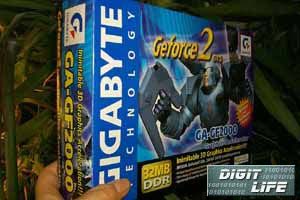 In the box:
OverclockingIn the previous article I mentioned that a 6ns memory means potential 30-50 MHz over the rated. That time we spoke about SDR-memory. I should say that this concerns DDR-memory as well; it is met rarely, though. There are quite a lot of video cards whose 166-MHz memory is limited, when overclocked, by 180-190 MHz. Infineon chips are especially hard to overclock. And today's sample allowed to reach 205 (410) MHz! It's nearly a record amongst all video cards of this class. And possibility to lift GPU frequency up to 230 MHz makes these overclocking results leading among 32-MBytes cards on the NVIDIA GeForce2 GTS (only the 64-MBytes ABIT Siluro GF256 GTS managed to reach 250 MHz). Note that while overclocking we used an additional fan installed inside the case. Installation and driversSuch a powerful processor was chosen in order to show the whole potential of the video card moving far away the CPU frames. The configuration of the test bed is following:
The card ships together with the drivers of 6.31 version. We carried out the tests with 6.47 version drivers (VSync was off). For comparison we used results of the following video cards: AOpen PA256 Deluxe, SUMA Platinum GeForce2 GTS and Inno3D Tornado GeForce2 GTS/64. Test resultsAgain, first comes the 2D-graphics. I many times stressed perfect 2D quality of the NVIDIA GeForce2 GTS based video cards (with the rare exception of the defective video cards). The example of the GA-GF2000 proves it. The majority of users will be satisfied with such quality. The speed parameters were considered in our first articles on the cards based on this chipset - they must suit the most exacting users. With the following 2 games we will consider speed level in 3D-graphics:
Quake3 ArenaThe test on the standard demo002 was carried out in two modes: Fast (shows card's work in 16-bit color) and High Quality (shows card's work in 32-bit color). 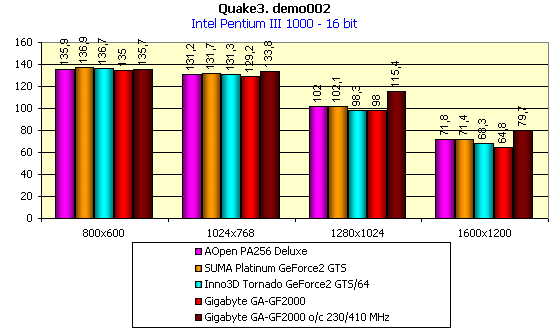  ExpendableWe will use this game to show the card's speed in Direct3D. 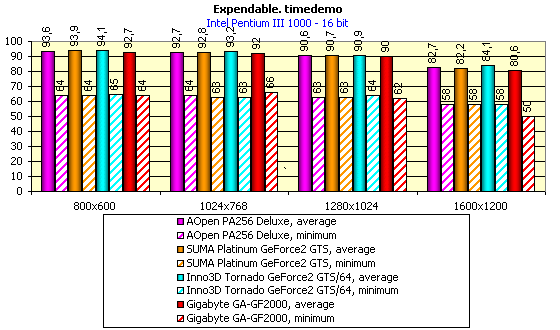 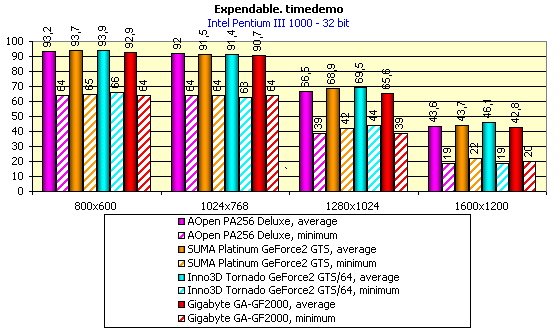 You see that differences from competitors are minimal, overclocking allows a considerable increase in performance (such high growth of the memory frequency positively influenced the speed increase in 32-bit color mode). Summary on the performance of the Gigabyte GA-GF2000:
ConclusionAs usual, Gigabyte company supplies not only a high quality product, that performs as equals with its counterparts, but it also has an indisputable advantage - a low price (for the end of 2001 it constitutes around $170-175). Indeed, taking a 32-MBytes video card on the NVIDIA GeForce2 GTS, the Gigabyte GA-GF2000 will be the best to go with. Highs:
Lows:
Write a comment below. No registration needed!
|
Platform · Video · Multimedia · Mobile · Other || About us & Privacy policy · Twitter · Facebook Copyright © Byrds Research & Publishing, Ltd., 1997–2011. All rights reserved. |